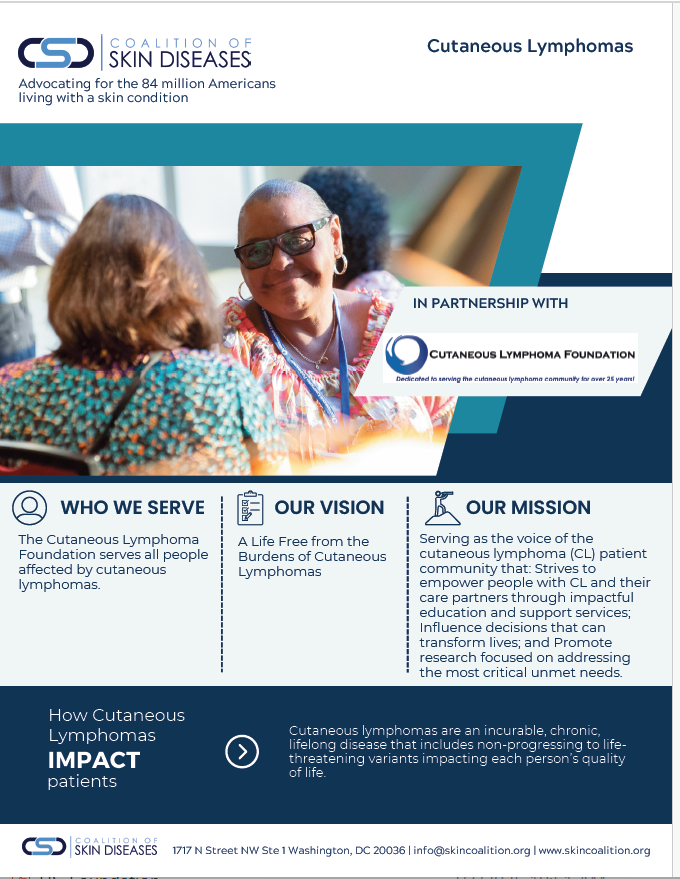Cutaneous lymphomas are types of non-Hodgkin’s lymphomas (NHL) that originate in the lymphocytes (white blood cells). Unlike most other types of NHL, which develop in lymph nodes, cutaneous lymphomas develop primarily in the skin.
Cutaneous lymphomas are types of non-Hodgkin’s lymphomas (NHL) that originate in the lymphocytes (white blood cells). Unlike most other types of NHL, which develop in lymph nodes, cutaneous lymphomas develop primarily in the skin. They can be classified into cutaneous B-cell lymphomas and cutaneous T-cell lymphomas, depending on which type of lymphocyte they originate from.
There are many forms of cutaneous lymphoma with a range of symptoms, outcomes, and treatment considerations. The most common types are cutaneous T-cell lymphomas, which make up 75-80% of all cutaneous lymphomas. Mycosis fungoides and Sézary syndrome are the most frequently diagnosed subtypes of cutaneous T-cell lymphoma. Cutaneous B-cell lymphomas originate in skin-based B-cells. Cutaneous B-cell lymphomas make up 20-25% of all cutaneous lymphomas and include a variety of subtypes; primary cutaneous follicle center lymphoma is the most common form.

As a group, cutaneous lymphomas are a relatively rare family of disease. There are an estimated 30,000 people in the United States and 3,000 people in Canada living with cutaneous lymphoma. Approximately 1,500 – 2,000 new cases are diagnosed each year across North America. There is general consensus that these numbers are low because they do not currently account for misdiagnosed or undiagnosed patients – it can be difficult to diagnose the disease in its early stages. It is important to know that cutaneous lymphomas are not contagious and cannot be passed from one person to another.
Cutaneous lymphoma presents differently in each patient, with variation in the degree of severity. Patches usually resemble a rash. Plaques are thicker, raised lesions that are usually itchy and are often mistaken for eczema, psoriasis, or dermatitis. Tumors are raised bumps that may or may not ulcerate. Patients can have any or all of these symptoms, but some people can have cutaneous lymphoma for many years with only one of these characteristic signs. Patients with Sézary syndrome often have extensive thin, red, itchy rashes (erythroderma) covering over 80% of their body. Patients may have enlarged lymph nodes or experience changes such as thickening on the palms of their hands and soles of their feet, brittle fingernails, hair thinning or hair loss, or drooping eyelids.
The course of this disease is not predictable, especially because it can be different for each individual patient. Most patients do not progress at all, while others can progress at varying rates. Most patients will have only skin symptoms and no serious complications. In approximately 10% of patients, the disease will progress with serious complications. Many patients live normal lives while they treat their disease.
With advances in research and new treatment options resulting from physician collaboration and clinical trials, cutaneous lymphoma patients are experiencing better care and an array of effective treatment options that work for them.
Treatment of cutaneous lymphoma depends on the stage and symptoms of the disease. A patient’s age, health status, and goals for treatment are also factors in treatment selection. For some patients with slow-growing or static disease, “watchful waiting” may be the best clinical course. For patients with fast-growing or advanced diseases, treatment is usually necessary.
Treatments are categorized as skin-directed or systemic (directed at the entire body). Skin-directed therapies include topical steroids, phototherapy, topical chemotherapy, and topical retinoids. Radiation therapies are focused on skin symptoms/lesions. They can be used alone or in combination, and selection is based on a patient’s specific symptoms. Systemic therapies reach the bloodstream and are distributed throughout the entire body, including the skin. Systemic therapies are generally used for more advanced or aggressive diseases.
The Cutaneous Lymphoma Foundation is the only patient advocacy organization devoted solely to cutaneous lymphoma. Its mission is to support every person affected by cutaneous lymphoma by promoting awareness and education, advancing patient care and fostering research for the best possible outcomes.
The Cutaneous Lymphoma Foundation serves the cutaneous lymphoma community by:
Visit the Cutaneous Lymphoma Foundation’s website:
Or contact us at Email: [email protected]
Phone: 248-6449014, ext. 1
The Cutaneous Lymphoma Foundation is a 501(c)(3) nonprofit organization supported by tax-deductible donations.

Connect with your federal legislators to speak up for dermatological conditions today.